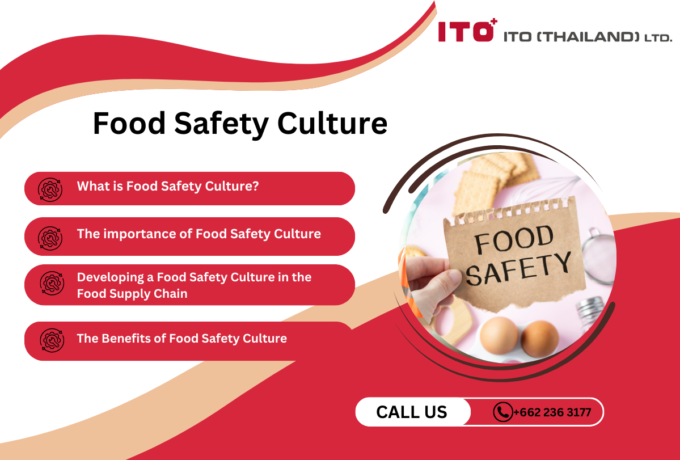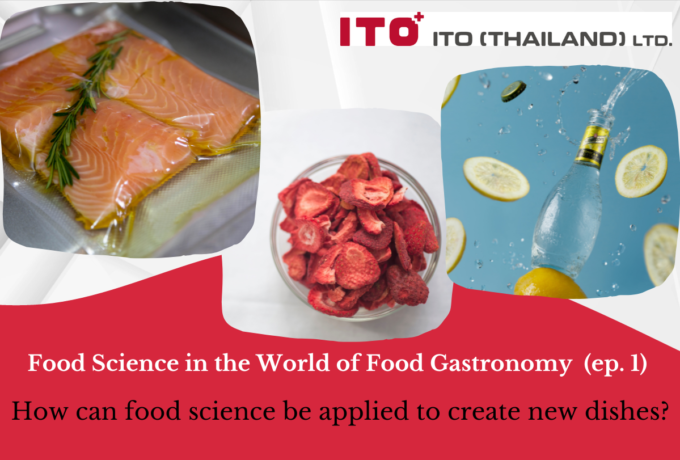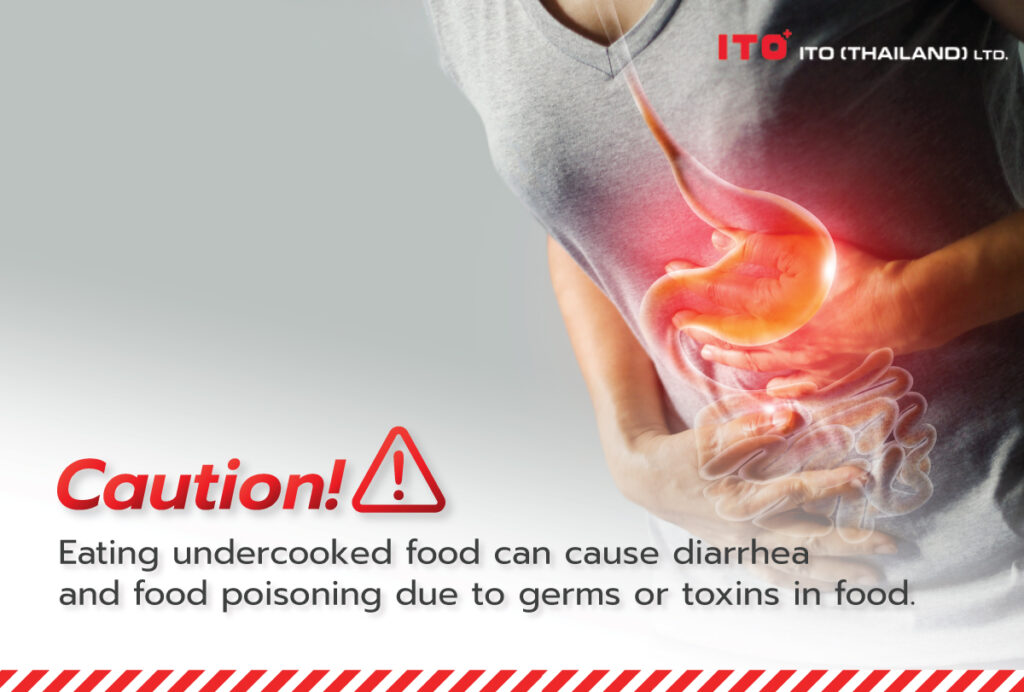ITO Thailand Hygiene Blog
Cross-contamination
What is cross-contamination? How is it important?
Originally, there were three types of food hazards: physical, chemical, and biological. Currently, allergen contamination has been added as the fourth category.
This cross-contamination is likely to occur at every step of the food supply chain, from raw material production (such as agriculture, livestock, fishery) to raw material harvesting, transportation and storage, food production, food storage, and transportation to food preparation by consumers. It can be direct contamination, such as hair getting into food due to poor hygiene of the operator, tool scrap contamination due to lack of proper maintenance, pesticide and hormone contamination in raw materials, airborne dust or aerosol contamination, or heavy metal contamination in industrial consumer water, for example. It can also be caused by accidental “cross” contamination from unclean food, such as pathogenic microorganisms containing allergens through various carriers to originally clean food. This exposes clean food to a risk of foodborne illnesses.
Cross-contamination is one of the main causes of foodborne disease. Therefore, food safety standards place a strong emphasis on cross-contamination control to reduce the risk and hazards of foodborne illnesses which may be contamination of germs especially pathogens, spores of bacteria and fungi, toxins, etc. And today, the Good Hygiene Practices (GHPs) add contamination of proteins that are allergens in allergen-free food as one of the cross-contaminations that requires control and monitoring.
Pathogenic microbial contamination among bacteria such as Salmonella, E. Coli, Clostridium, Staphylococcus, Listeria, and Campylobacter, viruses such as hepatitis A and fungi such as Aspergillus, pose a biohazard risk in food. The Food Safety and Inspection Service (FSIS), which reports directly to the Ministry of Agriculture of the United States recalled up to 20 products due to contamination of these germs in 2019 [2]. In addition to the cost of product recall and disposal, the organization also faced tarnished corporate image and confidence.
Carriers of cross-contamination and control
The source of cross-contamination is raw materials or food that has been previously contaminated by microorganisms, mold spores, allergens, etc., which can be transmitted directly to other foods or through carriers as follows:
♦ From food to food
Microbial contamination from raw food to cooked food or allergen contamination from raw materials that contain allergens to food that does not contain allergens is direct decontamination. For instance, putting microbially contaminated vegetables in salads or as a side dish to chili paste may cause the microbial to be contaminated with other vegetables. Or storing raw eggs with other foods may cause the microorganisms from the eggshell to contaminate the food. Or storing old food that may have microbial growth together with new food can cause microorganisms to contaminate new food as well.
Control can be done by separating food storage and production into cooked and raw zones, emphasizing that food that has been sterilized or cooked must be in a clean state.
Packaging must be clean and carried out in a clean condition. Operators must undergo cleaning and have good hygiene. New and old raw materials and products must be stored separately using the concept of FIFO (First In, First Out) so that old food that might have microorganisms growing is used first and not mixed with new food in the storage. As for the control of allergen contamination, separation of production units and separate storage of raw materials and products containing allergens away from allergen-free parts are the main approaches towards the prevention of cross-contamination. In case the same production unit is necessary, attention must be paid to cleaning to prevent cross-contamination, especially from carriers such as surfaces, machines, and equipment to food.
♦ From surfaces, machines, and equipment to food
Cross-contamination from carriers of surfaces, machinery, and equipment to food is the main path of indirect contamination from raw food or allergens to products, where microorganisms or allergens might be trapped in the nooks and crannies of the machines and equipment. Therefore, care is required in regular cleaning and disinfection of the machinery and equipment including frequently touched surfaces. In addition, separating sets of equipment, both food processing equipment (e.g., knives, cutting boards, work surfaces) and cleaning tools (e.g., brooms, mops, scrub brushes, tablecloths) for raw and cooked foods or zones with allergens, such as using color codes to identify devices is also another way to prevent cross-contamination.
♦ From humans to food
Cross-contamination from people to food is similar to contamination from equipment surfaces to food. That is, humans are considered the surfaces that come into contact with food. If touching contaminated food and clean food without cleaning and disinfecting in-between, contaminants will also be brought to clean food. The best method is cleaning and disinfection such as washing hands, washing shoes, changing clothes before entering the food production zone, or sharing equipment such as gloves to reduce the chance of contamination and it is easier to clean.
In summary, the prevention of cross-contamination is one of the cornerstones of food safety that operators both in households and the food industry must consider due to the risk of foodborne illnesses. Prevention can be achieved by separating contaminated food from uncontaminated food, washing hands, equipment, and machinery regularly as well as disinfecting to ensure the highest level of food safety for consumers.
Related Post
-

Food Safety Culture
Food safety culture plays a crucial role in safeguarding the company's reputation, ensuring the well-being of its employees, and providing a safe experience for its customers.
-

New food source safety issues
What are safety issues worth knowing for trendy new food sources like plant-based and insect-based proteins?
-

British Retail Consortium (BRC) Standard
Food safety management systems play a vital role in ensuring the production and distribution of safe and high-quality food products to consumers. With the global food supply chain becoming increasingly complex, food businesses must implement effective systems prioritising safety, quality, and compliance with industry standards. A food safety management system encompasses a set of procedures, processes, and controls designed to identify, prevent, and manage potential hazards at every stage of the food production and supply process. This proactive approach not only safeguards consumers' health but also protects the reputation and credibility of food companies in an ever more competitive market.
-

Food Science in the World of Food Gastronomy (Part 1)
How can food science be applied to create new dishes?
-

FSSC 22000
Food manufacturers must ensure food safety standards and processes. FSSC 22000 is an official certification program for Food Safety Management Systems (FSMS) recognised by the Global Food Safety Initiative (GFSI). This certification scheme offers a set of guidelines and procedures to ensure uniformity, openness, and safety across your entire supply chain. It applies to all companies operating within the food and beverage industry, ranging from farmers to retailers. By fulfilling the necessary criteria and obtaining FSSC 22000 certification, it is demonstrated that the required standards for food quality and implementing effective processes to manage and mitigate risks associated with food fraud, foodborne illnesses, expensive recalls, and other external threats are met.
-

Food Safety Aspects of Artificial Sweeteners
Artificial sweeteners, also known as sugar substitutes, non-nutritive sweeteners, or high-intensity sweeteners, are artificially produced compounds utilised in place of sucrose (table sugar) to add sweetness to food and drinks. Due to their significantly higher sweetness than regular sugar, only a fraction of artificial sweeteners (200 to 20,000 times less) is required to achieve an equivalent level of sweetness. Since the caloric contribution of these sweeteners, when used in such small quantities, is insignificant, they are often referred to as non-nutritive (4).










